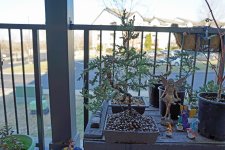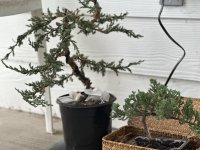nurvbonsai
Shohin
Hi everyone, I was hoping for feedback on my first attempt at repotting a juniper that I did in a workshop last year. I was encouraged by parties to go ahead the last week of February. Initially styled in a one gallon container, nothing quite prepared me for how stressful it was on me, let alone how the tree might respond. Given its initial home in the latter; i got to reduce the root ball in order to place the tree in its new container.
I believe it’s not as secured with wire as it could be. Could the rootball be reduced further given the mound? I’m stressed about it.
I’m sure others here could offer experience, strength and hope on more will be revealed.
Looking forward to the responses.
What say you? Thank you much. I plan on taking it into a nursery to see what could further be done. THANKS. Anxiety
I believe it’s not as secured with wire as it could be. Could the rootball be reduced further given the mound? I’m stressed about it.
I’m sure others here could offer experience, strength and hope on more will be revealed.
Looking forward to the responses.
What say you? Thank you much. I plan on taking it into a nursery to see what could further be done. THANKS. Anxiety





